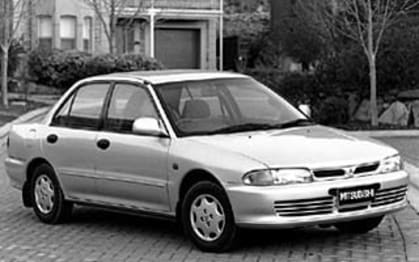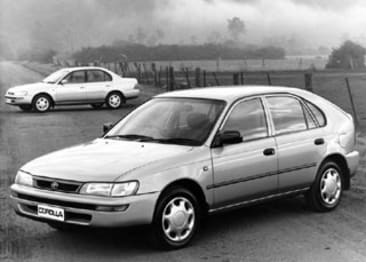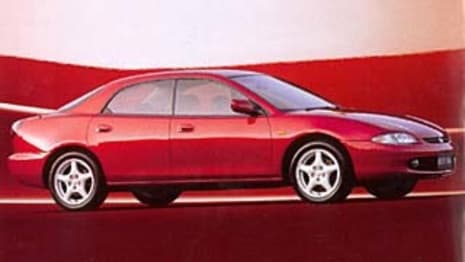
Used Mitsubishi Lancer review: 1992-1996
- Mitsubishi Lancer
- Mitsubishi Lancer 1995
- Mitsubishi Lancer 1992
- Mitsubishi Lancer 1993
- Mitsubishi Lancer 1994
- Mitsubishi Lancer 1996
- Mitsubishi Lancer Reviews
- Mitsubishi Reviews
- Mitsubishi Coupe Range
- Mitsubishi Sedan Range
- Mitsubishi Wagon Range
- Coupe
- Sedan
- Wagon
- Mitsubishi
- Used Car Reviews
- Small Cars

The great motoring revolution that has taken place in recent years was still a long way away from happening when Mitsubishi launched its small, front-wheel drive (CC) Lancer in 1992.
The early 1990s were simpler, more ordered times. Then, impoverished people bought small cars, those with a little more in the bank aspired to mid-sized models, while anyone who’d 'made it' steered big cars like Holdens and Fords.
Models
The CC Lancer range offered plenty of choice, with sedans, hatches, wagons and even coupes, and everything from budget cars to sporty rally-bred models.
At the entry-point of the range sat the GL, a sparsely equipped sedan, hatch, wagon or coupe with a 1.5-litre four-cylinder engine and a choice of five-speed manual gearbox or three-speed automatic transmission.
The standard features you got when you bought a GL Lancer were minimal, consisting of a steering column that could be adjusted for rake and reach, and a radio cassette player.
If you were feeling flush you could also have power steering, which was the sole optional extra available.
Next in line was the GLi wagon, with a 1.8-litre engine and the choice of five-speed manual gearbox or four-speed automatic transmission.
If you were feeling flush you could also have power steering, which was the sole optional extra available.
Standard features of the GLi were a radio cassette player with four speakers, the steering column was adjustable for rake and reach, and it had body-coloured bumpers. Power steering was optional.
The GLXi was available as a sedan, hatch, or coupe, and came with the extra zip of a 1.6-litre or 1.8-litre four-cylinder engine, and the choice of a five-speed manual gearbox or four-speed automatic transmission.
Standard features of the GLXi were a tachometer and remote releases for the boot/hatch, and like the GL, power steering was available as an extra cost option.
The SEi sedan, which had a 1.8-litre four-cylinder engine and the choice of five-speed manual gearbox or four-speed automatic transmission, was better equipped with a longer list of standard features.
Included were a radio cassette player with four-speakers, remote boot/hatch release, a tachometer, central locking, and power steering.
The Eli wagon also had a 1.8-litre four-cylinder engine, and the choice of a five-speed manual gearbox or four-speed automatic transmission.

Its list of standard features extended only to a four-speaker stereo sound system with a radio cassette player; power steering was optional.
The Executive arrived in 1993. It was available as a sedan, which replaced the GLXi sedan, and a wagon, with a 1.8-litre engine, and the choice of five-speed manual gearbox and four-speed automatic transmission.
Standard features were a steering column with tilt and reach adjustment, power steering and body coloured bumpers.
For more thrills there was the sizzling hot GSR boy racer sedan, with its turbocharged 1.8-litre, a five-speed manual gearbox and four-wheel drive grip.
When you bought the GSR you drove away with alloy wheels, ABS braking, sports suspension, power windows, front and rear spoilers, and central locking.

Air conditioning was offered as an option across the range in 1995, sadly it wasn’t automatic climate control air.
Bluetooth was still years away from being available, so there's no chance of connecting an iPhone or Android device.
It didn’t have sat nav or a touch screen either, or features like a reversing camera, parking sensors, or park assist.
Also missing was a sunroof option.
The spare tyre was full-sized.
Cabin
The CC Lancer’s cabin was quite roomy given the car's size, with seats for five, but it was a noisy place to be, with relatively high levels of engine and road noise.
In keeping with its place in the scheme of things, the GL’s cabin was bland, awash with grey plastic trim, and a mix of cloth and vinyl upholstery.

The other models in the range boasted cloth trim and cloth inserts in the doors. The driver’s seat was height adjustable and there was a remote release for the boot or hatch.
Storage options were limited; there was a glovebox and a centre console, but no cupholders.
Engine
The early 1990s was a time of transition for engine technology, and the engines used in the CC straddled the old and the new.
The old technology was represented in the 1.5-litre single overhead camshaft four-cylinder engine in the GL, which was fed by a carburettor.
At its best it put out 65kW of peak power, that’s a meagre 85 horsepower, it also produced a maximum 120Nm of torque.

The GL’s performance was further hampered by its three-speed automatic transmission, the alternative to the five-speed manual gearbox also offered.
Representing the new technology of the time was the 1.8-litre engine that powered the bulk of the models in the CC range.
It too had a single overhead camshaft, but had 16 valves compared to the 12 in the 1.5-litre engine, and it featured multi-point fuel injection.
As a result its peak outputs were 86kW (115 horsepower) and 161Nm of torque.
While that wasn’t particularly remarkable, it was willing enough to complete the 0-100 km/h sprint in around 10 seconds.
Performance was helped by the four-speed automatic transmission that came with the 1.8-litre engine, the popular alternative to the five-speed manual gearbox also available.
With 145kW (194 horsepower) and 255Nm on tap at its respective power and torque peaks, the GSR was a sizzling performer.

Behind the numbers was a turbocharged 1.8-litre four-cylinder with double overhead camshafts and multi-point fuel-injection.
It was only available with a five-speed manual gearbox and four-wheel drive.
All of the engines ran on 91-octane regular unleaded petrol.
Driving
The driving experience depended heavily on the model.
Models with the 1.5-litre carburettor engine didn’t excite the senses, but it was decent enough if you’re priority was door-to-door transport with respectable fuel economy.
Those with the 1.6-litre and 1.8-litre fuel-injected engines were smoother, they performed better, and returned good fuel efficiency.
With independent MacPherson strut front suspension and multi-link rear suspension the CC Lancer was smooth and comfortable, and its handling reassuring.
Being a light car the CC Lancer is not really suited to towing, although it does have a rated towing capacity of 750 kg when the trailer has brakes or 400 kg when it doesn’t. That limits it to a small trailer.
Safety
The CC Lancer had few of the safety features expected of a car today; there were no airbags, not even for the driver.
Crash protection was limited to the structure of the body itself, and seat belts.
When assessed based on real world crashes How Safe Is Your Car rated the CC Lancer ‘Good’.
While it had few passive safety features it also had few active safety features.
Brakes were a blend of front discs and rear drums, and only the GSR was enhanced with ABS anti-lock braking.
It was too early for ISOFIX baby car seat mounting points.
Any common issues?
Mechanics say the CC Lancer gives little trouble, though it's important to change the cam timing belt as per Mitsubishi's recommendation of 90,000km.
Generally the Lancer is a strong little car that stands up well, even with high odometer readings.
When shopping for an older car, such as the CC Lancer, it’s important to choose the one in the best condition, with the lowest odometer number, and the best service record.
Regular servicing is the key to reliability in the long term.
The oil to use in the 1.5, 1.6 and 1.8-litre engines is 10W-40; use 5W-40 in the 1.8-litre turbocharged GSR.
Capped price servicing was a thing of the future when the CC was launched, but the service costs are not excessive, and any competent mechanic can do it.
The warranty when new was for two years/50,000 km, whichever came first.
With a car that is likely to have done 250,000 km or more look for the signs of wear, such as oil leaks around the engine and transmission, and rattles from the engine on starting, smoke from the tailpipe under acceleration, and sloppy shifting from the auto transmission.
It’s important to look closely for evidence of crash damage. Any car that has been on the road for as long as the CC Lancer has been is likely to have been in a bingle, so look for dodgy repairs, poorly fitting panels, mismatched paint, rust, etc.
MORE: If anything crops up, you’ll probably find it on our Mitsubishi Lancer problems page.
Owners view
Harry Styles: My 1995 GLXi coupe has been a stout little runner with good reliability and looks that have aged well.
Louise Evans: I bought my GLi coupe secondhand in 2004. I liked its looks and the performance seemed good. My only complaint was the lack of room in the rear.
Pricing
| Year | Price From | Price To |
|---|---|---|
| 1996 | $1,980 | $4,070 |
| 1995 | $1,980 | $4,070 |
| 1994 | $1,380 | $4,070 |
| 1993 | $1,380 | $4,070 |
| 1992 | $1,380 | $4,070 |
Pricing guides
Range and Specs
| Vehicle | Specs | Price* | |
|---|---|---|---|
| GLXi | 1.8L, ULP, 4 SP AUTO | $1,980 – 3,080 | 1992 Mitsubishi Lancer 1992 GLXi Pricing and Specs |
| GL | 1.5L, ULP, 3 SP AUTO | $2,310 – 3,630 | 1992 Mitsubishi Lancer 1992 GL Pricing and Specs |
| GL | 1.5L, ULP, 5 SP MAN | $1,980 – 3,080 | 1992 Mitsubishi Lancer 1992 GL Pricing and Specs |
| GLX | 1.5L, ULP, 5 SP MAN | $1,380 – 2,200 | 1992 Mitsubishi Lancer 1992 GLX Pricing and Specs |
Other cars to consider
$2,310
Lowest price, based on third party pricing data








